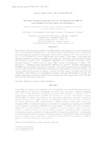Use este identificador para citar ou linkar para este item:
http://www.alice.cnptia.embrapa.br/alice/handle/doc/1058428Registro completo de metadados
| Campo DC | Valor | Idioma |
|---|---|---|
| dc.contributor.author | MELO, J. F. B. | pt_BR |
| dc.contributor.author | LUNDSTEDT, L. M. | pt_BR |
| dc.contributor.author | INOUE, L. A. K. | pt_BR |
| dc.contributor.author | METÓN, I. | pt_BR |
| dc.contributor.author | BAANANTE, I. V. | pt_BR |
| dc.contributor.author | MORAES, G. | pt_BR |
| dc.date.accessioned | 2016-12-12T11:11:11Z | pt_BR |
| dc.date.available | 2016-12-12T11:11:11Z | pt_BR |
| dc.date.created | 2016-12-12 | pt_BR |
| dc.date.issued | 2016 | pt_BR |
| dc.identifier.citation | Arquivo Brasileiro de Medicina Veterinária e Zootecnia, Belo Horizonte, v. 68, n. 5, p. 1251-1258, 2016. | pt_BR |
| dc.identifier.uri | http://www.alice.cnptia.embrapa.br/alice/handle/doc/1058428 | pt_BR |
| dc.description | The activities of enzymes from a number of metabolic pathways have been used as a tool to evaluate the best use of nutrients on fish performance. In the present study the catfish Rhamdia quelen was fed with diets containing crude protein-lipid-carbohydrate (%) as follows: treatment (T) T1: 19-19-44; T2: 26-15-39; T3: 33-12-33; and T4: 40-10-24. The fish were held in tanks of re-circulated, filtered water with controlled temperature and aeration in 2000L experimental units. The feeding experiment lasted 30 days. The following enzymes of the carbohydrate metabolism were determined: Glucokinase (GK), Phosphofructokinase 1 (PFK-1), Pyruvate kinase (PK), Fructose-1,6-biphosphatase 1 (FBP-1). The activities of 6 phosphogluconate dehydrogenase (6PGDH) and glucose 6 phosphate dehydrogenase (G6PDH) were also assayed. The influence of nutrient levels on the enzyme activities is reported. The increase of dietary protein plus reduction of carbohydrates and lipids attenuates the glycolytic activity and induces hepatic gluconeogenesis as a strategy to provide metabolic energy from amino acids. The fish performance was affected by the concentrations of protein, lipid and carbohydrates in the diet. The greatest weight gain was obtained in fish fed diet T4 containing 40.14% of crude protein, 9.70% of lipids, and 24.37% of carbohydrate, respectively. | pt_BR |
| dc.language.iso | eng | eng |
| dc.rights | openAccess | eng |
| dc.title | Glycolysis and gluconeogenesis in the liver of catfish fed with different concentrations of proteins, lipids and carbohydrates. | pt_BR |
| dc.type | Artigo de periódico | pt_BR |
| dc.date.updated | 2016-12-12T11:11:11Z | pt_BR |
| dc.subject.thesagro | Enzima | pt_BR |
| dc.subject.thesagro | Metabolismo | pt_BR |
| dc.subject.thesagro | Peixe | pt_BR |
| dc.subject.thesagro | Nutriente | pt_BR |
| dc.subject.thesagro | Bagre | pt_BR |
| dc.subject.thesagro | Proteina | pt_BR |
| dc.subject.nalthesaurus | Fish | pt_BR |
| dc.subject.nalthesaurus | Catfish | pt_BR |
| dc.subject.nalthesaurus | Enzymes | pt_BR |
| dc.subject.nalthesaurus | Metabolism | pt_BR |
| dc.subject.nalthesaurus | Fish nutrition | pt_BR |
| riaa.ainfo.id | 1058428 | pt_BR |
| riaa.ainfo.lastupdate | 2016-12-12 | pt_BR |
| dc.identifier.doi | 10.1590/1678-4162-8337 | pt_BR |
| dc.contributor.institution | J. F. B. MELO, UNIVERSIDADE FEDERAL DO VALE DO SÃO FRANCISCO - UNIVASF - Petrolina-PE; LICIA MARIA LUNDSTEDT, CNPASA; LUIS ANTONIO KIOSHI AOKI INOUE, CPAO; I. METÓN, UNIVERSIDAD DE BARCELONA; I. V. BAANANTE, UNIVERSIDAD DE BARCELONA; G. MORAES, UFSCar-São Carlos, SP. | pt_BR |
| Aparece nas coleções: | Artigo em periódico indexado (CNPASA)  | |
Arquivos associados a este item:
| Arquivo | Descrição | Tamanho | Formato | |
|---|---|---|---|---|
| CNPASA2016abmvz.pdf | 199,29 kB | Adobe PDF |  Visualizar/Abrir |









